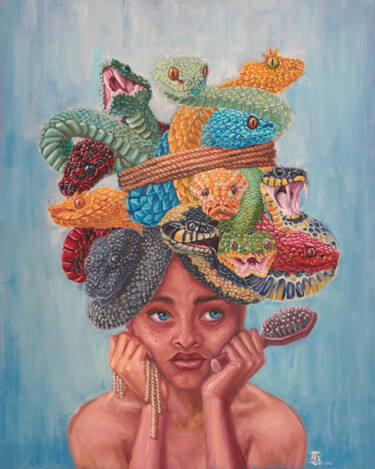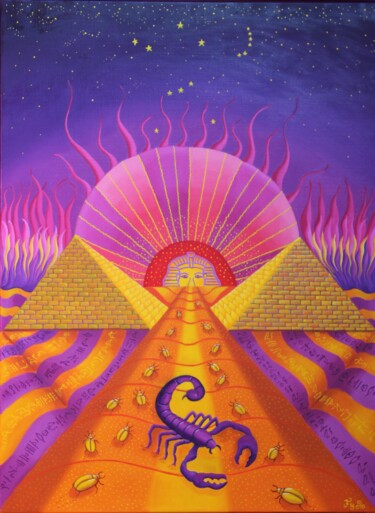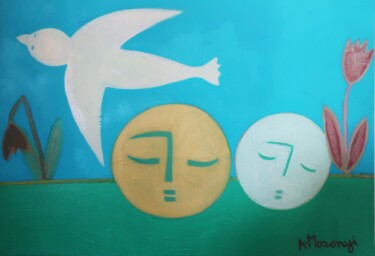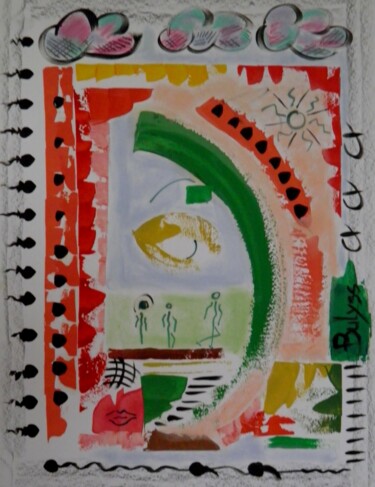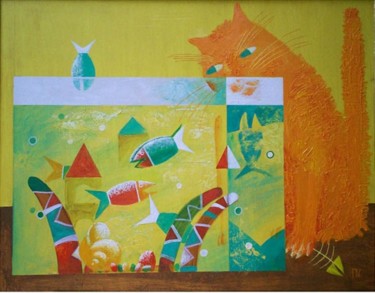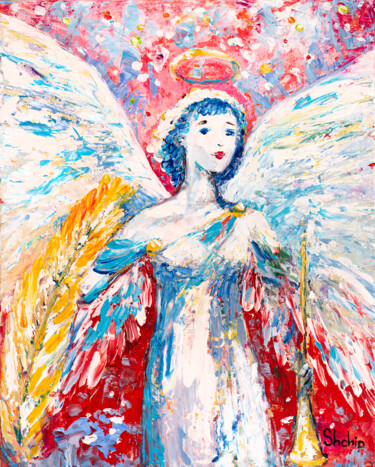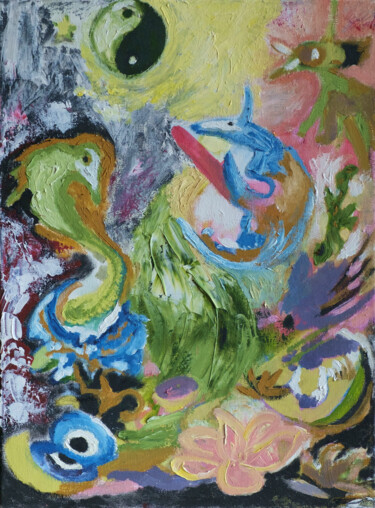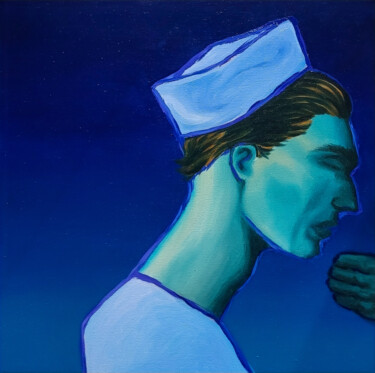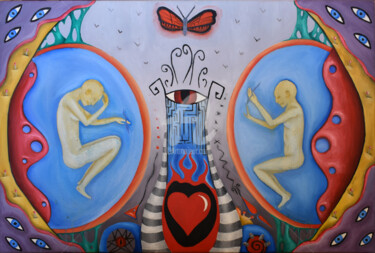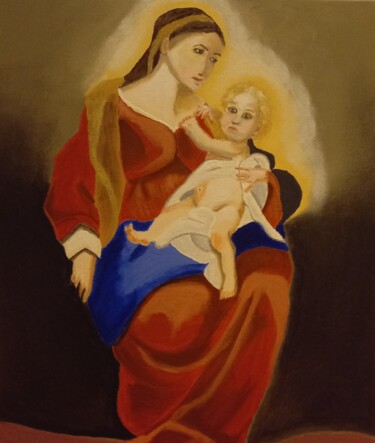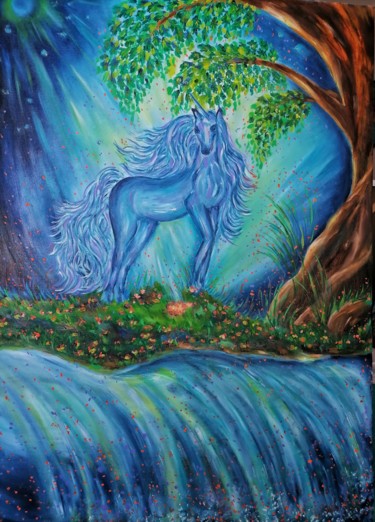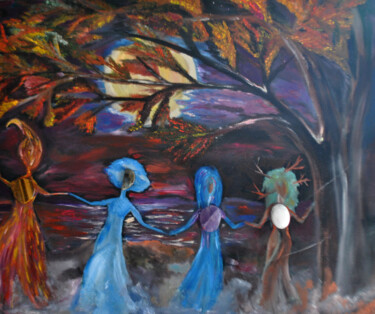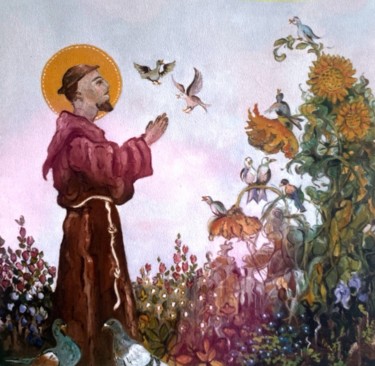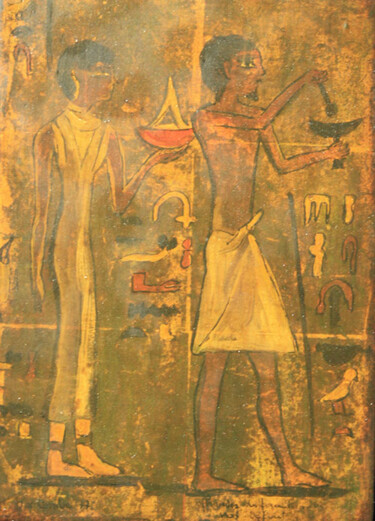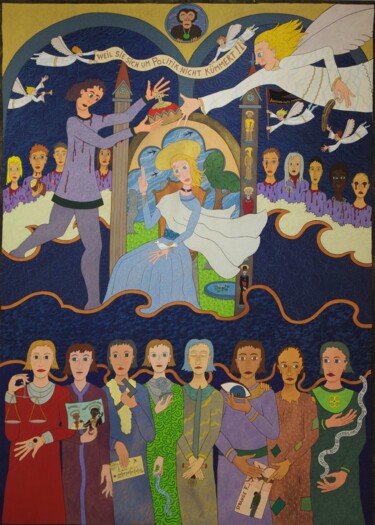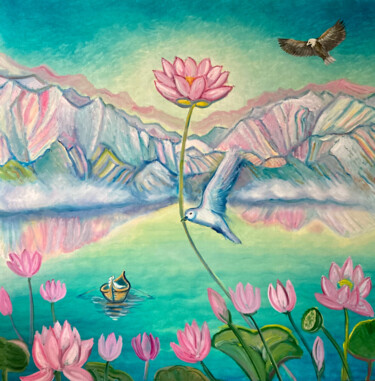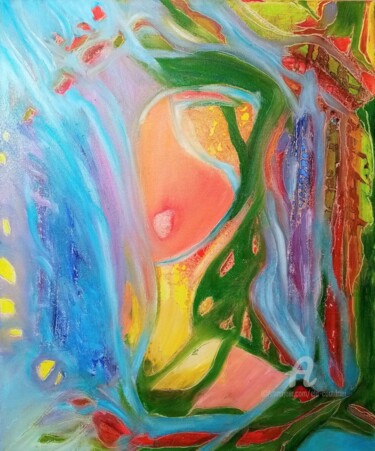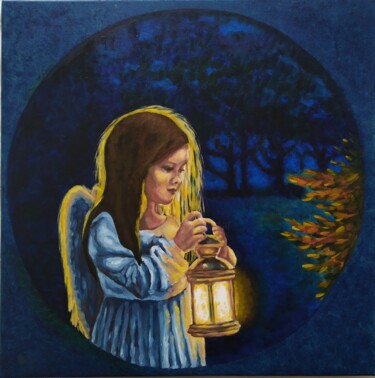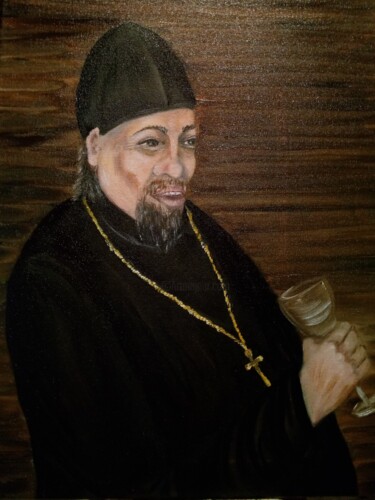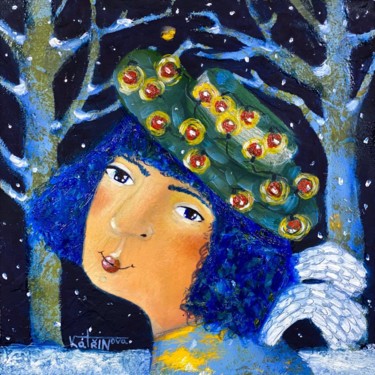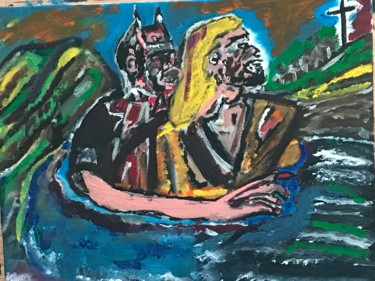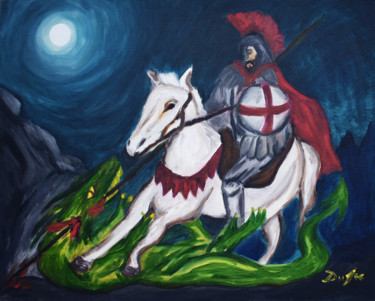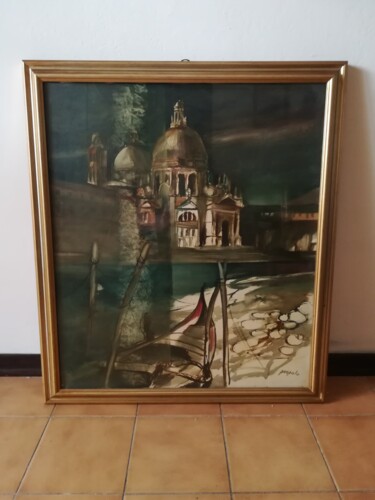31 Pinturas originales para la venta:
¿Cuál es el origen de la técnica Oleo
Cuadro compuesto por pigmentos encuadernados con aceite de linaza o claveles. La técnica tradicional consiste en superponer capas de pintura cada vez más rica en aceite para un agarre fuerte y duradero. La pintura al óleo utiliza una sustancia cuyo aglutinante consiste en un aceite secante que envuelve las partículas de pigmento. Esta técnica pictórica ha atravesado los tiempos gracias a sus cualidades plásticas. A finales de la Edad Media, sustituyó a la técnica del temple, luego su uso se generalizó gracias a los primitivos flamencos, en particular a Jan Van Eyck que lo utilizó ampliamente. Por lo general, consta de pigmentos de color y un aglutinante que puede ser aceite de linaza, aceite de clavel o incluso aceite de nuez. Muchos artistas han experimentado con esta técnica reina de la pintura al óleo, en particular pintores barrocos como Pierre Paul Rubens, o incluso románticos como Eugène Delacroix o Théodore Géricault.
¿Cómo definir estilo Arte naíf ?
What is a Naive painting?
Naive painting is a style of art that was started by artists like Henri Rousseau who didn't know much about art. Most of the time, naive art is defined as visual art made by someone who hasn't had the training and education that a professional artist does. When a professional artist tries to copy this style, it is often called "primitivism."
What are the characteristics of Naive painting?
Naive art is usually defined as visual art made by someone who doesn't have the formal training and education that a professional artist does (in anatomy, art history, technique, perspective, ways of seeing). When a trained artist tries to copy this style, it is sometimes called primitivism, pseudo-naive art, or faux naive art.
Unlike folk art, naive art doesn't have to come from a specific popular cultural context or tradition. In fact, at least in advanced economies and since the Printing Revolution, it's impossible not to know about the local fine art tradition, which has spread through popular prints and other media. Naive artists know about "fine art" conventions like graphical perspective and compositional conventions, but they can't or don't use them to their full potential. Outsider art (also called "art brut"), on the other hand, refers to works that come from a similar background but have little to do with the mainstream art world.
Naive art is known for being simple and honest like a child, and this is why it is often copied. These kinds of paintings usually have a flat style of drawing and a simple way of showing depth. Henri Rousseau, a French Post-Impressionist who lived from 1844 to 1910 and was discovered by Pablo Picasso, was one of the most important painters of "naive art."
There has been some disagreement about what the term means and where it "ends" with other terms like folk art and outsider art. Naive art is usually used to describe works of fine art made by self-taught artists, like paintings and sculptures. Folk art, on the other hand, refers to things that can be used in everyday life. But this difference has been argued about. [6] "Provincial" is another word that can be used, especially for paintings and buildings. It is mostly used to describe work by artists who have had some traditional training but whose work falls short of metropolitan or court standards by accident.
By what do naive paintings stand out?
People often think of naive art as art made by someone who hasn't had any formal training or a degree, or hasn't had much. Before the 20th century, this was true, but now there are schools for naive art. Naive art is now a fully recognized type of art that can be seen in galleries all over the world.
The features of naive art don't fit well with the formal aspects of painting, especially when the three rules of perspective aren't followed (as described by the Progressive Painters of the Renaissance):
-Objects get smaller as you get farther away,
-Colors become less clear as you get farther away;
-Details become less clear as you get farther away.
Here are the results:
-Geometrically wrong effects of perspective (awkward parts of the works, like how children's drawings or paintings from the Middle Ages look, but that's where the comparison ends);
-Effects of perspective that aren't quite right. Strong use of pattern, unrefined color on all the plans of the composition, without enfeeblement in the background;
-Equal attention to details, including those in the background that should be shaded off.
People say that naive art is easy to spot because it is not complicated. It has become so popular and well-known, though, that many examples could be called "pseudo-naive." "Pseudo naive" or "faux naive" art is the work of an artist who is more imitative or self-conscious and whose work looks more copied than original. "Naive" art is the work of an artist who did not go to art school or academy, like Henri Rousseau or Alfred Wallis.
Since Autodidactism has become more popular as a way to learn in modern times, strict naiveté is not likely to be found in modern artists. Living artists don't always like naive categorizations, but this is likely to change as more dignifying signals become known. There are now museums for naive art in Kecskemét, Hungary; Kovaica, Serbia; Riga, Latvia; Jaen, Spain; Rio de Janeiro, Brazil; Vicq, France; and Paris. Gary Bunt, Lyle Carbajal, Gabe Langholtz, Gigi Mills, Barbara Olsen, Paine Proffitt, and Alain Thomas are all English-speaking living artists who admit to having a naive style.
"Primitive art" is another term that people who haven't studied art often use to describe it. Historically, though, it has been used more to describe art from cultures that Western academia has deemed "primitive" socially or technologically, like Native American, sub-Saharan African, and Pacific Island art (see Tribal art). This is different from the "primitive"-inspired, self-aware movement called "primitivism." Folk art is another term that is similar to naive art but not the same thing.
There are also the terms "navism" and "primitivism," which are usually used to describe professional painters who use naive art as their style (like Paul Gauguin, Mikhail Larionov, Paul Klee).
What is the history of the Naive movement?
No one knows exactly when the first naive artists started making art, but from the very beginning of art to the time of the "Modern Classic," naive artists have left behind clear signs of their creative work. At the very least, naive art has been "official" in the history of 20th-century art since 1912, when an almanac called Der Blaue Reiter was published. Wassily Kandinsky and Franz Marc, who made the almanac, showed six copies of Henri Rousseau's paintings and talked about how they were different from other pictures. Most experts agree, though, that naive art was "discovered" in 1885, when the painter Paul Signac learned about Henri Rousseau's skills and started putting on shows of his work in some of the best galleries in Paris.
The Sacred Heart painters
Wilhelm Uhde, a German art collector and critic, is known for being the main person in charge of the first Naive Art show, which took place in Paris in 1928. Henri Rousseau, André Bauchant, Camille Bombois, Séraphine Louis, and Louis Vivin all took part. Together, they are known as the Sacred Heart painters.
Earth Group
The Earth Group (Grupa Zemlja) was a group of artists, architects, and thinkers from Croatia who lived and worked in Zagreb from 1929 to 1935. The group was Marxist and was partly based on "Neue Sachlichkeit,"[19] which led to more stylized forms and the start of Naive painting. In the group were painters Krsto Hegedui, Edo Kovaevi, Omer Mujadi, Kamilo Ruika, Ivan Tabakovi, and Oton Postrunik, sculptors Antun Augustini and Frano Krini, and the architect Drago Ibler. The Earth group tried to figure out how to solve social problems. Their program stressed the importance of creative freedom and was against blindly copying styles from other countries. They didn't want to make art just for the sake of art. Instead, they thought it should reflect the real world and the needs of the modern community. The government of the time was getting more and more upset by what was going on at the group's exhibitions, so in 1935, the group was banned.
Hlebine School
From about 1930 on, this term was used to describe naive Croatian painters who worked in or around the village of Hlebine, which is near the border with Hungary. At this time, the village was just "a few muddy, winding streets and one-story houses," according to the World Encyclopedia of Naive Art (1984). However, it produced such a great crop of artists that it became almost synonymous with Yugoslav naive painting.
Hlebine is a small, beautiful town in the north of Croatia. In the 1920s, a group of self-taught peasants started to paint in a way that was different and even a little bit revolutionary. Leading intellectuals of the time, like the poet Antun Gustav Mato and Miroslav Krlea, the most famous name in Croatian literature, pushed for this. They wanted a unique national style of art that was not influenced by the West. Krsto Hegedui, a well-known artist from Hlebine, took these ideas and used them to start the Hlebine School of Art in 1930. He did this to find "rural artistic expression" on a national level.
Ivan Generali was the first master of the Hlebine School. He was also the first artist to create a unique style and reach a high level of art. After the Second World War, the next generation of Hlebine painters focused more on stylized, made-up pictures of life in the country. Generali stayed the most important person and helped other artists, including his son Josip Generali, get started. With the 1952 Venice Biennale and shows in Brazil and Belgium, the Hlebine school became known all over the world.
Some of the best known naive artists are Dragan Gaži, Ivan Generalić, Josip Generalić, Krsto Hegedušić, Mijo Kovačić, Ivan Lacković-Croata, Franjo Mraz, Ivan Večenaj and Mirko Virius.
What are some famous Naive paintings?
Naive art is made up of simple, childlike techniques and ideas. Because of this, modernists who don't like what they see as the fake sophistication of work made in the traditional system have praised it. Henri Rousseau is the best-known naive artist working today, so we'll start with one of his works.
The Dream (1910) by Henri Rousseau
The young girl has been taken to a jungle, where a local musician plays a brass instrument and sings to her. Yadwigha, who is half hidden by the jungle's shadows, reaches out to the musician while looking out over a beautiful view of jungle greenery with lotus petals, parrots, monkeys, an elephant, two lions, and a snake. The snake coming toward the scene in the lower right corner of the picture makes me think of the Garden of Eden. A pink snake moves through the bushes. Its shape, which is like a snake, looks like a woman's legs and hips.
In this piece of art, a naked model is sitting on a sofa, which brings together the familiar and the strange. The painting "The Dream" shows why the Surrealists liked Rousseau's work. It has amazing attention to detail, bright colors, and a strange mix of images.
At least 22 different shades of green were used to paint the jungle plants. Poet and art critic Guillaume Apollinaire was blown away by the work. "The painting is absolutely gorgeous!" he exclaimed. I don't think anyone will laugh this year."
This picture looks like a dream because the only thing in it is a naked woman lying on a sofa in the tropics. But it's not clear if the art shows Yadwigha's dream or Rousseau's. But one of the best things about the picture is how open it is to different interpretations. Rousseau's trips to the natural history museum and the Jardin des Plantes in Paris gave him ideas for this piece, which has a lush jungle, wild animals, and a mysterious horn player. "When I'm in these hothouses and see strange plants from other places, it feels like I'm entering a dream," the artist said of his visits.
Death ship (1942) by Alfred Wallis
The main idea behind Alfred Wallis's Death Ship is a huge black ship with dark gray steam billowing from it. Five sailors in black suits and caps can be seen as the ship moves over icy white water. This picture, which has a good name, is a great example of the kind of work Wallis did in his later years. They show how sad the artist was feeling at the time.
Wallis made these paintings while he was alone and his eyesight was getting worse and his mind was getting worse. No one knows for sure when Wallis finished making these last changes. They were made either while Wallis was living in the Madron poorhouse or just before he was sent there, which was something he had been afraid of for a long time. Death Ship disproves the idea that Wallis couldn't use deep and complicated symbolism in his work because he was a "naive" artist. The ship is a sign of death and destruction, which is more of a metaphor than a literal representation of the things Wallis paints. It is a mix of the feelings Wallis had when he was at sea and when he was near the coast of St. Ives.
The Broken Column (1944) by Frida Kahlo
After she was badly hurt in a car accident when she was 18, most of Frida Kahlo's self-portraits are about her physical and mental pain. As her health got worse, this theme came back and got much stronger as her life came to an end. Her graphic pictures of herself in pain show how hard it was for her to deal with physical problems and pain. "The Broken Column," a painting by Kahlo, was made soon after she had surgery on her back.
This was just one of many times she had to go to the doctor to fix problems caused by an injury she had in the past. Kahlo had to wear a steel corset while painting, which was different from the plaster casts she had worn before. In the picture, Kahlo is standing in a broken, empty place that looks like it has been through as much trouble and tragedy as she has. Due to a deep, jagged crack that runs the length of her almost-naked body, her spine looks like a broken Ionic stone column. Her spinal column looks like it's about to break, especially at the bottom. Nails of different sizes go through her whole body and face, making her pain even worse. She has a lot of tears running down her cheeks.
Kahlo painted herself naked at first, except for the medical support girdle she wears. Then she added a white covering that looks like it came from a hospital to cover her bottom half. Her breasts are showing, and even though her body has been cut up, her sensuality shines through. The way nails and sheets are shown also has strong echoes of the Christian symbol of martyrdom. Even though she is in pain, Kahlo's face shows that she is strong and will not give up. Even though her body has been hurt and tortured, it is clear that her spirit has not been hurt.
This is the end of our look at Naive art, a style that looks simple and childlike. This word is used to describe paintings made in cultures that are more or less advanced but don't have the traditional skills to draw things. The colors are bright and not natural, the view isn't scientific, and the meaning is literal or childish.
Compra de obras de arte sobre el tema del " Espiritualidad "
En todo momento, la espiritualidad ha sido un elemento consustancial para los hombres que buscaban sentido en sus vidas. Una búsqueda de lo sagrado que no ha escapado a los artistas de cada época que siempre han buscado representar en sus obras esta necesidad de fe. Ya sea en forma de las diferentes religiones monoteístas (cristianismo, judaísmo, islam), las diferentes religiones politeístas del mundo, creencias paganas, supersticiones, leyendas antiguas o mitologías fundadoras ... La espiritualidad ha dejado una huella muy importante en el mundo. Obras de Arte como "La creación de Adán" de Miguel Ángel o "La última cena" de Leonardo da Vinci se encuentran entre las obras más significativas de la historia del arte. El arte espiritual es un modo de expresión artística que mezcla tiempo, religión y misticismo en el proceso de realización de una obra. Esto se puede manifestar independientemente de la creencia o el fundamento teológico. Los artistas adheridos a este modo de expresión pueden prosperar en diferentes temas relacionados con lo divino: reencarnación, meditación, contemplación, esoterismo, despertar, iluminación, devoción, sabiduría, búsqueda psíquica, médium ... El espiritismo en la pintura ha inspirado fuertemente a artistas famosos como como Piet Mondrian, Vassily Kandinsky, Georgiana Houghton o Kasimir Malevich.
¿Estás buscando Pinturas originales a la venta ?
Explora todos los estilos y todas las técnicas de pintura: pintura contemporánea, arte callejero, arte abstracto, arte figurativo, paisajes, retratos, naturalezas muertas, desnudos, acuarela, pintura al óleo, pintura acrílica ... Artmajeur es para todas las sensibilidades artísticas y celebra la belleza a tu lado para 20 años con más de 2 millones de obras de arte contemporáneo por descubrir ... ¡o adquirir! El referente mundial de la pintura contemporánea. ¡Descubre obras de artistas contemporáneos de todo el mundo para decorar tu interior con clase! ¿Amante del arte simple o coleccionista confirmado? Encuentra el lienzo o cuadro favorito que realmente realzará tu decoración. Artmajeur te ofrece obras originales, ediciones limitadas e impresiones artísticas de los mejores artistas contemporáneos del mundo. En Artmajeur, las pinturas son seleccionadas por entusiastas y expertos en el mercado del arte. Seleccionamos para usted las obras originales de pintores de moda, galardonados y reconocidos, así como nuevos valores en ascenso en el campo del arte contemporáneo para guiarlo y ayudarlo en su proceso de compra de pinturas en línea.
¿Cómo comprar una pintura al óleo online?
Imagínese el día en que realmente considere comprar una pintura al óleo en línea. Si encuentra una imagen que agrada su vista y su presupuesto, es fácil navegar a través de una galería de arte en línea porque piensan en todo.
¡Comprar arte es pan comido! Artmajeur había implementado su propio sistema (lo que la gente podría llamar "el motor de Google") para que los clientes ahorren tiempo investigando grandes piezas sin tener que visitar las galerías.
Pero aún hay otras opciones que puede tener además de comprar una pintura al óleo en línea . También puede explorar los estilos de acrílico y acuarela.
Puede comprar pinturas al óleo en línea con solo unos pocos clics. No solo eso, sino que verá miles de imágenes en las galerías de arte. ¡El sitio web le permitirá elegir entre nuestra amplia oferta de cuadros de miles de artistas, estilos y tamaños sin tener que salir de su propia casa! Pedir una obra original es tan fácil como seleccionar la pieza perfecta para usted o para otra persona. Simplemente agregue una obra de arte a su carrito y podrá ver si está disponible antes de hacer clic en "comprar" para que no haya sorpresas al pagar. Debe leer la política de envío de la empresa y las reseñas de personas en Google. Simplemente navegue por la web en su tiempo libre durante unos días antes de tomar una decisión.
Pero si realmente desea comprar pinturas al óleo en línea, sería útil encontrar un sitio web que brinde consejos sobre cómo comprar estas obras de arte. La mayoría de los sitios web le darían consejos sobre cómo elegir qué pintura comprar y también le darían una breve explicación.
Si eres un amante del arte y coleccionista, pedir una pintura sobre lienzo también es una gran idea para un regalo para tus seres queridos en ocasiones especiales como cumpleaños, bodas, Navidad ...
También puede comprar pinturas al óleo en línea que pueden ser estacionarias o pueden ser pinturas al óleo que puede montar en sus paredes grandes. Puede comprar lienzos enmarcados o sin enmarcar, comprar una obra de arte original o una impresión de bellas artes de edición limitada. Además, puedes filtrar tu búsqueda por color, tamaño, tema ...
Cuando compre una pintura al óleo en línea, encontrará que hay muchas opciones. Puedes comprar un retrato simple o puedes comprar una pieza abstracta. Puedes comprar paisajes o puedes comprar retratos. Las opciones son infinitas. En general, comprar una pintura en línea es realmente una experiencia genuina .
Imagínese la expresión del rostro de su ser querido cuando desenvuelve una hermosa pintura al óleo y se da cuenta de que la compró en línea. Eso es lo que puede ofrecerles con nuestro sitio web de fácil navegación, Artmajeur.com, donde tenemos miles de opciones disponibles para todos los presupuestos, gustos u ocasiones. ¡Explore nuestro sitio ahora y encuentre la obra de arte perfecta hoy al mejor precio!
Si está buscando una pintura de arte moderno para decorar su hogar u oficina, ofrecemos una amplia gama de pinturas al óleo de artistas de todo el mundo. Nuestra selección incluye piezas abstractas con colores vivos y retratos realistas que se adaptarán a cualquier estilo. También tenemos disponibles lienzos de gran tamaño, para que puedas crear un espacio único hecho de arte mural. Explore nuestro sitio web hoy mismo para encontrar obras de arte únicas que harán que sus paredes sean excepcionales.
Descubre Obras de arte contemporáneo en Artmajeur
El arte contemporáneo es una vibrante constelación de expresiones artísticas. Este universo creativo abarca una amplia variedad de medios, desde pinturas, esculturas y fotografías hasta dibujos, grabados, arte textil y arte digital, cada medio es una estrella que brilla con su propio resplandor distintivo. Los artistas utilizan diversos soportes y materiales para dar vida a sus visiones, como lienzo, madera, metal e incluso innovadores lienzos digitales para la creación de obras maestras virtuales.
Una pintura contemporánea, por ejemplo, puede tejer su historia a través de los trazos magistrales de acrílico o óleo, mientras que una escultura contemporánea puede cantar su canción en el lenguaje de la piedra, el bronce o objetos encontrados. Las artes fotográficas capturan y manipulan la luz para producir imágenes impactantes, mientras que la técnica de la impresión utiliza técnicas como la litografía y la serigrafía para producir múltiples de una sola imagen impactante. El arte textil juega con telas y fibras, mientras que el arte digital empuja los límites de la creación con tecnología innovadora.
El atractivo del arte contemporáneo reside en su naturaleza desafiante de límites, su búsqueda constante de la experimentación y su reflexión constante de la evolución de la experiencia humana. Esta creatividad ilimitada, junto con su fuerte comentario social y personal, hace que cada pieza de arte contemporáneo sea un emblema único de su tiempo, un espejo que refleja las realidades y los sueños de nuestro complejo mundo. Nos susurra, nos mueve, provoca el pensamiento y enciende una respuesta emocional profunda, agitando el alma de cualquiera dispuesto a escuchar. Es, en efecto, el lenguaje de emociones e ideas, hablado en el dialecto de nuestra era.

©2023 Fouschy
Orígenes e historia del arte contemporáneo
La historia del arte contemporáneo se desarrolla a mediados del siglo XX, marcado por cambios sísmicos en la expresión artística. Después de la Segunda Guerra Mundial, alrededor de los años 50 y 60, los artistas comenzaron a experimentar más allá de los límites tradicionales, desafiando las normas de lo que el arte podía ser. Esta época revolucionaria dio lugar a una gran cantidad de nuevos movimientos y formas artísticas, como el expresionismo abstracto, el arte pop y el minimalismo. Las pinturas, antes confinadas al realismo, abrazaron la abstracción, ya que los artistas utilizaron el color y la forma para expresar emociones e ideas. Períodos notables como el advenimiento del arte pop a finales de los años 50 y principios de los 60 vieron obras de arte que imitaban la cultura popular y los medios de comunicación masiva, reflejando el cambio de enfoque de la sociedad.Las artes escultóricas también presenciaron una metamorfosis. Los escultores comenzaron a experimentar con nuevos materiales y formas, a menudo creando obras de arte que interactuaban con el espectador y el espacio circundante, fomentando una sensación de compromiso. El dibujo, una práctica atemporal, también evolucionó, con artistas que incorporaban técnicas y conceptos innovadores para redefinir su papel en el arte contemporáneo.
La fotografía, un medio relativamente nuevo, surgió como una herramienta poderosa en el panorama del arte contemporáneo. Nacida en el siglo XIX, realmente se consolidó en la segunda mitad del siglo XX, difuminando las líneas entre el arte y la documentación. La técnica de impresión, una práctica que se remonta a la antigüedad, vio renovado interés y experimentación con técnicas como la litografía, el grabado y la serigrafía ganando prominencia.
El ámbito del arte textil se expandió dramáticamente, ya que los artistas comenzaron a apreciar la versatilidad y la calidad táctil de las telas y las fibras. Los artistas comenzaron a utilizar textiles para desafiar los límites entre el arte, la artesanía y el diseño.
El inicio de la tecnología digital a finales del siglo XX anunció una nueva era para el arte contemporáneo. El arte digital surgió cuando los artistas comenzaron a aprovechar nuevas tecnologías para crear experiencias inmersivas e interactivas, a menudo difuminando la línea entre el mundo virtual y el físico.
A través de estos períodos transformadores, la esencia del arte contemporáneo ha permanecido igual: una reflexión dinámica y en constante evolución de los tiempos en los que vivimos, siempre empujando límites y abrazando lo nuevo, siempre cuestionando, siempre explorando.Evoluciones de estas obras contemporáneas en el mercado del arte
A medida que navegamos por el siglo XXI, el dinámico panorama del arte contemporáneo continúa evolucionando y expandiéndose, reflejando nuestro mundo en constante cambio. Las pinturas contemporáneas, antes principalmente confinadas a lienzos bidimensionales, ahora abarcan una multitud de formas y técnicas, desde instalaciones de medios mixtos hasta creaciones digitales, cada pieza un rico tejido de pensamientos, emociones y narrativas. La escultura, también, ha ido más allá de la piedra y el bronce tradicionales, con artistas incorporando luz, sonido e incluso movimiento, encarnando la efimeridad y el flujo del mundo moderno.La fotografía, en manos de Artistas Contemporáneos, ha expandido sus horizontes, mezclándose sin problemas con la tecnología digital para crear imágenes impresionantes que desafían nuestra percepción de la realidad. El dibujo, también, ha trascendido las fronteras del papel, incorporando elementos multimedia y técnicas exploratorias para redefinir su papel en el discurso artístico. La técnica de grabado sigue floreciendo, con artistas contemporáneos utilizando métodos tradicionales de maneras innovadoras para entregar comentarios sociales y personales potentes.
El arte textil, antes considerado como una artesanía, ahora ocupa un lugar prominente en el mundo del arte contemporáneo, con artistas que lo utilizan para explorar temas de identidad, tradición y patrimonio cultural. Mientras tanto, el arte digital, el miembro más nuevo de la familia del arte contemporáneo, ha revolucionado la forma en que creamos e interactuamos con el arte, presentando experiencias inmersivas que difuminan la frontera entre lo virtual y lo físico.
Estas diversas formas de arte contemporáneo tienen un valor significativo en el mercado del arte actual, no solo debido a su atractivo estético sino también a su capacidad para encapsular y comunicar ideas y emociones complejas. Coleccionistas, curadores y amantes del arte en todo el mundo buscan estas obras, atraídos por su inherente dinamismo, su uso innovador de materiales y sus expresiones elocuentes de nuestra experiencia humana compartida. Como testimonio de nuestros tiempos, estas obras de arte contemporáneo encapsulan el pulso de nuestra sociedad y la resonancia de las voces individuales, grabando para siempre nuestra narrativa colectiva en los anales de la historia del arte.
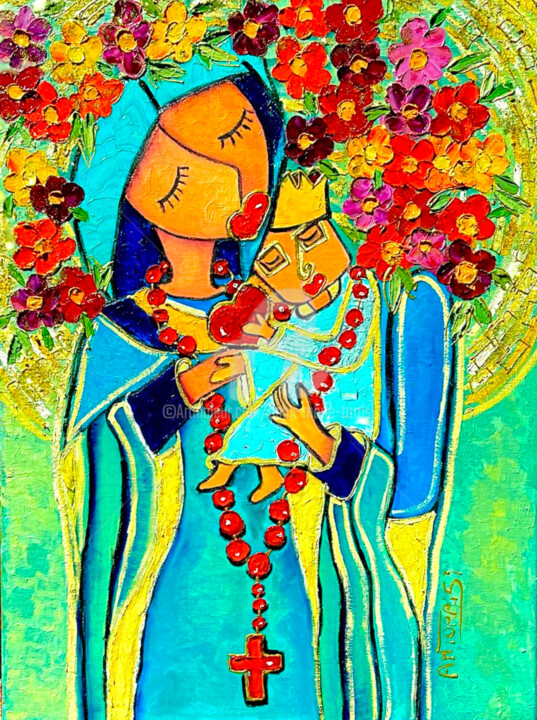
©2022 Anne Marie Torrisi
Artistas contemporáneos famosos
Al adentrarnos en el vibrante mundo del arte contemporáneo, nos encontramos con una variedad de artistas que dan forma a este campo dinámico. Cada uno es un maestro en su medio - pintura, escultura, fotografía, dibujo, grabado, textil o arte digital - que empujan los límites artísticos, reflejando nuestra era y desafiando las percepciones. Vamos a explorar a estos notables contribuyentes y sus obras innovadoras.
1. Gerhard Richter - Conocido por su enfoque multifacético en la pintura, Richter desafía los límites del medio, oscilando magistralmente entre estilos abstractos y fotorealistas. Sus obras, ya sea presentando pigmentos tirados con raspador o imágenes fotográficas borrosas, se involucran en un diálogo fascinante con la percepción.
2. Jeff Koons - Una figura destacada en la escultura contemporánea, Koons crea piezas monumentales que exploran temas de consumismo, gusto y cultura popular. Sus icónicos animales de globos, construidos en acero inoxidable pulido a espejo, cautivan con su comentario juguetón pero profundo.
3. Cindy Sherman - Una aclamada fotógrafa, Sherman utiliza su lente para explorar la identidad y los roles sociales, especialmente de las mujeres. Renombrada por sus autorretratos conceptuales, asume una miríada de personajes, empujando los límites de la fotografía como medio de expresión artística.
4. David Hockney - Hockney, con su prolífica producción que abarca seis décadas, es una figura clave en el dibujo contemporáneo. Su uso audaz del color y su lúdica exploración de la perspectiva transmiten una embriagadora sensación de alegría y una celebración desinhibida de la vida.
5. Kiki Smith - Una impresora innovadora, el trabajo de Smith explora la condición humana, particularmente el cuerpo femenino y sus connotaciones sociales y culturales. Sus grabados y litografías hablan de experiencias universales de la vida, la muerte y la transformación.
6. El Anatsui - Un maestro del arte textil, Anatsui crea impresionantes instalaciones similares a tapices a partir de tapas de botellas y retazos de aluminio descartados. Estas relucientes y flexibles esculturas combinan la estética africana tradicional con la sensibilidad del arte contemporáneo, abordando temas de consumo, desperdicio y la interconexión de nuestro mundo.
7. Rafael Lozano-Hemmer - Una figura destacada en el arte digital, Lozano-Hemmer utiliza la tecnología para crear instalaciones interactivas que combinan la arquitectura y el arte de la performance. Su obra, a menudo participativa, explora temas de vigilancia, privacidad y la relación entre las personas y sus entornos.

©2022 Laurent Mangepapier
Obras de arte contemporáneo destacadas
El panorama del arte contemporáneo es un mosaico dinámico de diversas expresiones e ideas innovadoras, cada obra de arte es un diálogo único con su audiencia. Aquí hay una selección de algunas obras de arte contemporáneo de renombre, que abarcan varios medios como la pintura, la escultura, la fotografía, el dibujo, el grabado, el arte textil y el arte digital, que han influido profundamente en este movimiento vibrante.
Estas piezas, en su diversidad, ejemplifican la rica variedad del arte contemporáneo, cada pieza es un comentario único sobre nuestro mundo y un testimonio del potencial ilimitado de la expresión creativa.
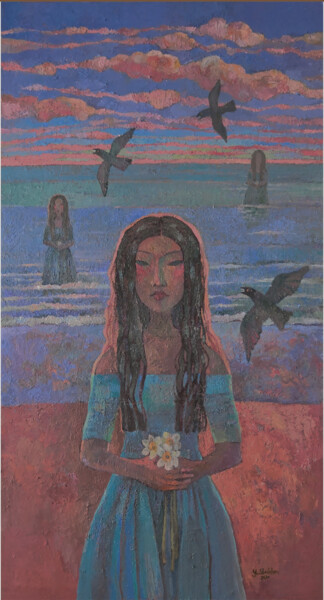
Yulduskhon
Oleo en Lienzo De Lino | 51,2x27,6 in

Aleksandra Kataranchuk
Oleo en Lienzo De Lino | 19,7x23,6 in
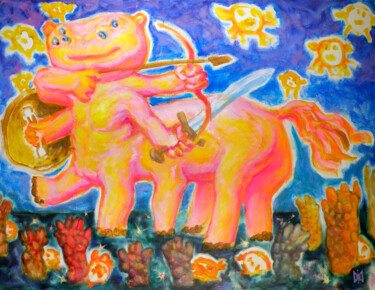
Mimi Hi
Oleo en Lienzo De Lino | 33,5x43,3 in
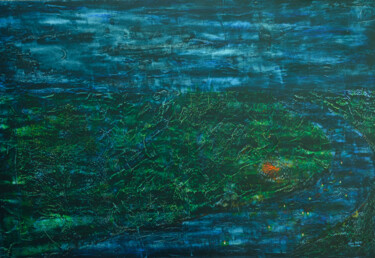
Sergiy Totuha (Totuha)
Oleo en Tablero de MDF | 31,5x46,9 in
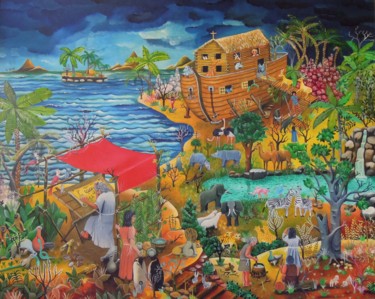
Gérard Michel
Oleo en Lienzo De Lino | 28,7x36,2 in
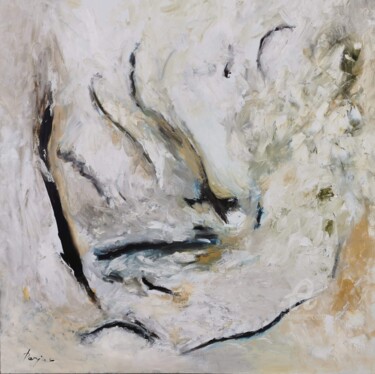
Anna Perjan
Oleo en Lienzo De Lino | 35,4x35,4 in
